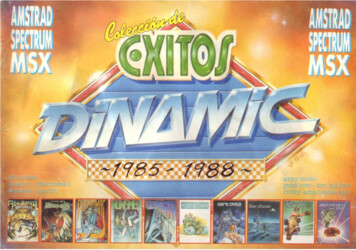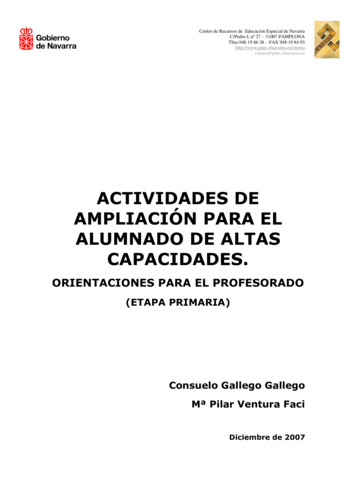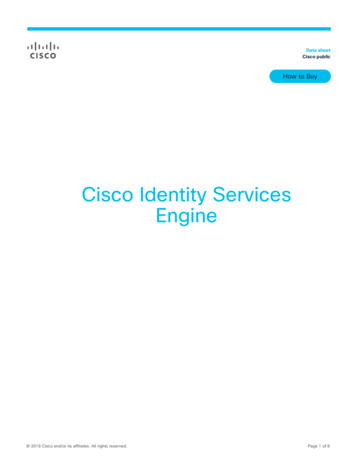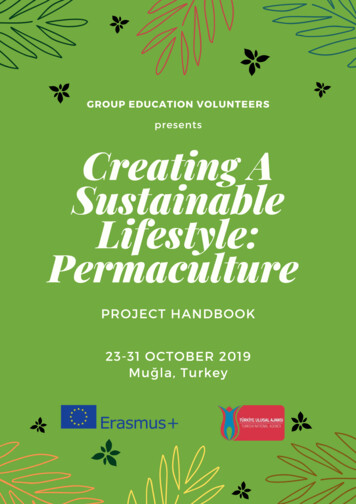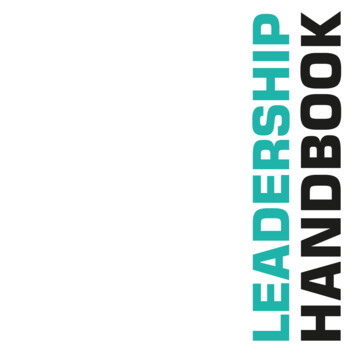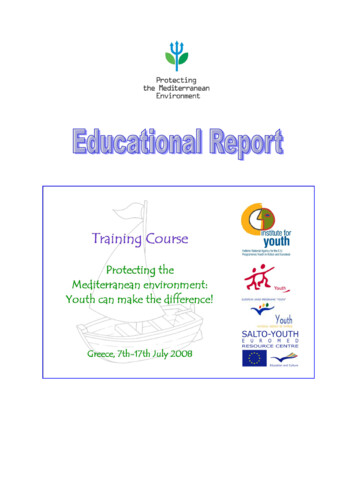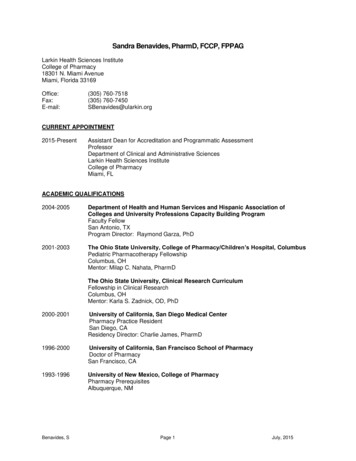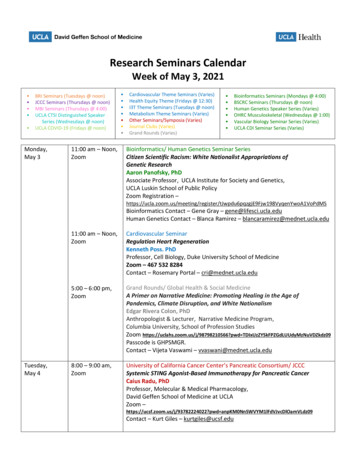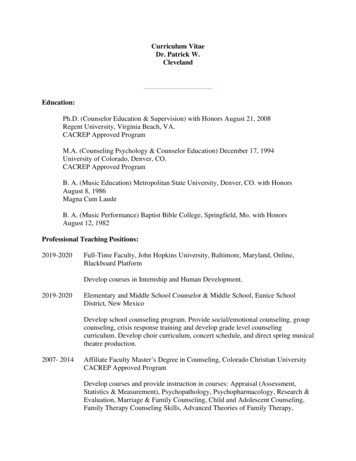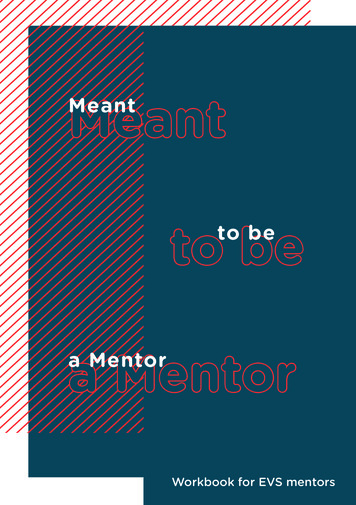
Transcription
MeantMeantto beto bea Mentora MentorWorkbook for EVS mentors
MeantMeantto beto bea Mentora Mentor
Content5A few words beforehand6How to use this workbook?91. Pictures of EVS – Picture EVS132. EVS as a process of change203. My role as a mentor284. CLEAR meetings365. Exploring possibilities, takingaction476. Supporting the learning of thevolunteer607. Mentors for mentors – Peer support688. Meant to be a Mentor BlendedTraining Course819. Resources – Links and literature
A few wordsbeforehandMentors have played a significant role in the European Voluntary Serviceprojects starting with the Youth, Youth in Action Programme till now, theErasmus Programme. Over these years EVS support structure has beendeveloped by host organisations and by National Agencies.Since 2011 the Polish National Agency has been supporting mentors byorganising annual training courses dedicated specifically to them1 in orderto ensure a high quality level of support for volunteers’ learning processduring EVS activities.Experience gained during the training courses and the need to address thisissue led to an innovative idea to create a long-term project guiding mentorsstep by step through the whole EVS project cycle. The content of this blendedtraining “Meant to be a Mentor” was the basis for this workbook.Both the training event and the publication would not exist without closecooperation with the Lithuanian National Agency: Monika KėžaitėJakniūnienė – trainer, Viktorija Malinauskienė and Aistė NatkevičiūtėČiplinskienė – European Voluntary Service members of staff, MichaelKimmig – trainer and author of this book and Urszula Buchowicz – EuropeanVoluntary Service member of staff.I believe that this workbook will provide a helpful set of tools and methodsfor mentors and all people interested in mentoring in the EVS context asa special way of supporting the learning process of young people.Mr. Tomasz BratekDeputy of the General Director of the FDES,Director of the Erasmus ProgrammeWarsaw, July 20151. “Mentor w roli głównej” (2011), “Mentor,czyli kto?” (2012, 2013), and “Mentoringfor Change” (2013). Download links to thefinal reports of these events in the chapter“Resources – Links and literature”.5
How to use thisworkbook?This workbook is for you!What you won't find here is a lot of information about EVS nor theperspective of the National Agencies on EVS. There is no need toreinvent the wheel - there are already a lot of great publicationson the European Voluntary Service (EVS) out there. 2However, what is not out there is a practical guide with ideas howEVS mentors can work with their volunteers. With this workbookwe would like to fill this gap. It is meant to serve as a practicalguide for your work with your volunteer(s).How to get started?Every chapter is divided into several parts:»»a chapter outline and overview,»»a brief introduction into the main content,»»a suggestion for one or more activities that you can carry outand practise mentoring skills,»»a few questions that help you to review your experience, and»»a list of useful resources.To make these activities work for you, your volunteer and yourorganisational context you might need to adapt them to yourneeds and situation.2. For examples please look in the chapter “Resources – Links and literature”.
How can I make the best of this workbook?Follow the outline of the chaptersThe most important points will be presented and lead youdirectly to a practical activity. You'll benefit most from thisworkbook if you don't only read about, but actually carry outthe suggested activities.Find a partner to learn/practise withSome activities are for yourself only, some others you may wantto carry out directly with your volunteer. You might feel morecomfortable trying out the activities with someone first to seeif you are heading in the right direction. You can do this withanother mentor, a co-worker or a friend. If you feel ready, youcan integrate them into your mentoring activities.Take notes and reflect on your experienceHow did it work? What went well? What doesn't work for you?What would you change/do differently next time? You can takenotes for yourself right in this workbook (Yes, it's yours!) So,underline, circle around, write down your thoughts, comments,recommendations, etc.7
Share and discuss your experience with othermentorsIf you have the chance to share and reflect on your experiencewith someone else, great. Otherwise (or additionally!) subscribeto the Google Community “Meant to be a Mentor” and shareyour experience and recommendations with other mentors.www.goo.gl/qiXKeRReady to go?Enjoy exploring, practising and learning!Michael Kimmig
1. Pictures of EVS– Picture EVSAct as if what you domakes a difference. It does.William JamesVoluntary work has very different faces: short-term, mid-term andlong-term services, voluntary activities on local, regional, national andinternational level, volunteering as a service, a learning experience,a contribution to community development, as part of developmentcooperation, etc. Each one has its own approach, philosophy andvalues.Even if we look only at European Voluntary Service (EVS), the worldof voluntary projects is very colourful and diverse. Reality shows thatEVS is organised and carried out in many different ways.In this part we will explore pictures of EVS, mainly from thevolunteers’ perspective: What does EVS mean to volunteers? Whatis the main idea of and what are the main values behind EVS?Your part will be to add to this picture YOUR point of view, taking intoaccount the local and organisational context.9
AimsContentActivitiesGetting to know the EVSprogramme from thevolunteers’ sideThe volunteers’ perspectiveon EVSPictures of EVSReflecting on your ownexperience of EVSPicture EVSThe main ideas/values of EVSMy personal ideas/values of EVS as a mentorLet’s look for some inspiration. Just watch a few videoson EVS, each of them highlighting different aspects ofvolunteering. Focus on the different ideas and values that areshown in these videos.www.goo.gl/l76CKCThese videos are just the tip of aniceberg!»»Did you enjoy watching them?»»Do you know any other videoexamples?
Activity: Pictures of EVSThe first activity is about gathering even moreinspiration, from various sources.1. Search for other “pictures” of EVS on YouTube,Vimeo, Facebook or other video platforms. Maybeyou'll also find videos that represent the perspectiveof the programme, of organisations, of mentors?2. Post them in the M2beaM community on Google .Write one or two sentences explaining your choice.Think about all thedifferent actors involved inrealising EVS:What values and main ideasdo you think EVS represents?What values are there for allthe different actors involved?Activity: Picture EVSNow it is time to explore your picture of EVS:»»How do you understand EVS?»»How did you see it in your own experience as a volunteer?»» How do you experience it from your perspective now(taking into consideration your organisation’s profile, the localcommunity and regional context)?1. Find a creative way to express your picture:»»take a photograph and/or use an existing one,»»create a mind-map, a collage or land art (usingmaterials from nature),»»build something from plasticine or any othermodelling material,»»draw, paint, write, or»»do anything else that comes to your mind!11
2. Share it with someone and/or takea picture of your work and post it in theM2beaM community.To close this chapter, two questionsto reflect on:What values and main ideas arerepresented in your picture of EVS?What are the values of all thedifferent actors involved as far as yourorganisational context is concerned?www.goo.gl/qiXKeRResourcesEuropean Voluntary Service (by MOOC on Erasmus (2015)»»Discoverthe Aims of European Voluntary Service (by MOOC on Erasmus (2015))»»Understand»»Pictures of EVS (YouTube playlist)
2. EVS as a processof changeThings do not change;we change.Henry David ThoreauLooking at its overall picture EVS looks like a journey with the maincharacter going on a quest. S/he encounters a problem, conflict orchallenge, which s/he needs to cope with. After going through aseries of adventures, the hero(ine) manages to complete the questand finishes his/her journey enriched.This journey is often a journey of change (or changes).EVS is full of changes: arriving in another country, carrying out newtasks/projects, finding a new role within an organisation, organisingeveryday life, building new contacts and creating a new social net,trying out new things, changing routines, behaviour, habits, etc.is the key word during an EVS project. Since the preparations until the“ Changereturn to your country you have to face millions of changes, in your lifestyle, in“your routine, in your habits, and hopefully, in yourself.An ex-volunteer from PortugalIf you want to support volunteers during change, it is crucial tounderstand the very phenomenon of change and conduct an indepth analysis of key moments related to the participation in EVS.13
AimsContentActivitiesUnderstanding the processof changeChange, Change processand stagesUnderstanding changeIdentifying importantaspects and stages ofchangesEVS as a process of change/changesKey moments in EVSRoles and tasks of a mentorRoles and tasks of mentorsIdentifying key moments inthe overall EVS process of avolunteerIdentifying mentor’s rolesand tasks connected tothese key momentsLife is full of changes – smaller or bigger ones. Life is an ongoingprocess of change. If you look back on your own experience as avolunteer or your own life experience it makes very much senseto look at it as a process of change or even changes.Instead of looking into theory, let's develop it ourselves. Let'shave a closer look at change and change stages.activity: Understanding ChangeIf you look into literature you'll find plenty of stories or fairy tales aboutchange. Here are a few inspirations.»»“Autobiography In Five Chapters” (Sogyal Rinpoche: Tibetan Book ofLiving & Dying) www.goo.gl/apLguD»»“Alice's Adventures in Wonderland” book and a fragment of theanimated film “Alice in Wonderland – Caterpillar” (the caterpillar asking"who are you”)»»“Who moved my cheese?”, book and animated film (by Spencer Johnson,1998)»»A fragment of the programme “Britain’s got talent” featuring SusanBoyle
(You find all video clips available on www.youtube.com or on the YouTubeplaylist "Stories of change”)www.goo.gl/EYBUA9Enjoy the material.»»Which one is your favourite?»»What other stories and fairy talesabout change do you know?Choose one story or fairy tale on which you would like to focus. Maybethe inspiration provided does not fit your image of change and you wouldlike to work with another fairy tale, poem, novel, story, etc. Feel free to doso. Do not analyse your own story of change, rather see your own journeyreflecting in the material. Choose something and use it as a metaphor.Look closely at the chosen story and answer the following questions:1. What is change? How would you describe it?2. What different aspects of the change process have you discovered byreading/watching your material?3. What stages/phases of change can you identify?Based on the material you created your own model of change and changestages. As a follow-up you can do the following.1. Look up several change models in literature.2. Ask yourself:»»What are they especially focussing on?»»How do these models compare to the one you created?»»What would you like to add to your own model of change?15
In the literature you may find plenty of models that describe personalchange. I personally like John Fisher's Transition Curve because it describesemotions that are associated with moving through the transition (anxiety,happiness, fear, threat, guilt, anger) as well as reactions towards change(depression, denial, disillusionment, hostility, gradual acceptance, movingforward). With the help of this model one can identify and read betterthe signs of emotions one gets caught in in the process of change. (ViewFisher's “Process of Transition” diagram on pdf)www.goo.gl/JCKwtcActivity: Key moments in EVSSo far you have worked on your own understanding of changeand had a look at Fisher's model of transition.Based on your understanding of change and change stages, havea look at the EVS volunteer's life cycle:1. What key moments of change can you identify in the EVSproject? Additionally you can ask: What change processesdoes the volunteer go through during his/her service? Whatchallenges does s/he meet?2. Go through the whole time of being a volunteer. Note down allkey moments that come to your mind and create a timeline forall the changes a volunteer goes through.Activity: Role and tasks of a mentorYou might want to compare your list with the collection below.These key moments were developed by mentors in our "Meantto be a Mentor” blended training course.
Now analyse the different key moments and ask yourself:1. What are the volunteer's emotions in these moments? (or:How does the volunteer feel in this moment/situation?)2. What are the volunteer's needs in these moments? (or: Whatdoes s/he need facing those challenges and/or going throughthese changes?)3. And last but not least: What is my role and my task asa mentor?Fill in your ideas into the table below.Key moments of EVSStagesKey momentsI. Before leaving“Birth” of EVS (gettingthe idea for EVS)EmotionsNeedsMentor's tasks/roleDecision and beingacceptedPreparations andgoodbyesII. ArrivalArriving and firstimpressionsTransition crisis(Culture shock)Growing independence17
III. In-betweenMid-evaluationUnfolding the fullpotentialChange of one’s rolewithin the organisationConfrontingthe futureIV. EndingSummarising andclosingFinal Happening(initiative, project)Reflection andevaluationPlanningthe futureDeparture andgoodbyesV. After EVSFollow-upEVSTransition crisis(Re-entry shock)Returning or startingoverAnytimeUnexpectedincidentsFinally, there comes one more question to reflect on:How does the perspective on change and change stages on the one hand andkey moments of a volunteer’s journey on the other hand, change your image ofmentor’s role?
Make some notes and share your thought inour M2beaM community!www.goo.gl/qiXKeRResources»»A conversation on managing change (by Michael Kimmig and Eliza Zadłużna 2012)»»Autobiography In Five Chapters (by Sogyal Rinpoche)»»Fisher's process of personal change (by Businessballs 2015)»»Fisher's “Process of Transition” diagram (by John M. Fisher 1999/2012)»»Stories of Change – YouTube playlist19
3. My role asa mentorThe delicate balance of mentoringsomeone is not creating them inyour own image, but giving them theopportunity to create themselves.Steven SpielbergAfter picturing EVS and a more in-depth understanding of changes duringEVS, let’s stop here for a moment and take the opportunity to clarify anddefine the mentor’s role.“ Mentor is a person that can help a volunteer to reflect on his/herexperiences and through the process of reflection help to find a personalway of change, if it is wanted by the volunteer. Mentor also oversees suchprocesses as acculturation, cultural shock, learning process during thevolunteering experience, and is capable of reacting in those momentswhen the need is felt or observed. Mentor can be also open to meeting thevolunteer not only for reflection, but also bonding as friends, to be able tocreate a trust-based relation between them.A mentor of the M2beaM BTC“2014-2015What would be YOUR definition of an EVS mentor?A general definition would lead us in a wrong direction. The activitysuggested is meant to send you out and clarify this together with yourvolunteer in a form of an agreement or contract.
AimsContentactivitiesClarifying and defining therole of a mentorRole of a mentorMake an agreement/contract with the volunteerContract guidelinesMaking an agreement/contract with your volunteerMy role as a mentorOne of the most frequently asked questions ofmentors is about his/her role:»»What is exactly a mentor?»»What does a mentor do?»»What are his/her tasks and roles?“Mentor is at the sametime both a friend anda professional.““Mentor is a friend in a foreigncountry.“Mentor is accompanying thevolunteer but at the same timehe can learn from him, too.Mentor (.) a wise andtrusted counsellor or teacher,supporter. a problem shooter, crisismanager, information pointand friend to the volunteer.Source: Mentors of the M2beaM BTC2014-2015“21
It is not only a tricky question for mentors who are new toEVS, but also for those who supported many generationsof volunteers. The mentor's role depends very much on thereality of the project, the organisational context (the Hostingand/or Coordinating organization, whether s/he is part of theorganisation or not, etc.) and, last but not least, on the volunteerthemselves.The mentor's role needs to be constantly redefined and agreedon with every single volunteer for every project and organisation.How to do this? How to shape your relationship with yourvolunteer?Looking at the mentor-volunteer relationship, we can identifyfour main elements that have an impact on the relationship: thementor, the volunteer, the theme/topic and the context.The relationship betweenmentor and volunteerTheme/topicContextI (mentor)VolunteerrelationshipSource: Theme-centered Interaction, adopted for one-to-oneconsultations and mentoring
Let's have a look at them one by one:The nce (as a volunteer),»»needs and interests,»»professional experienceand competence (language,communication, interculturalcompetence, problem-solving,mentoring, etc.).The rience,»»needs and interests,»»competences (language,communication, interculturalcompetence, cooperation, problemsolving, etc.),»»etc.The theme/topic»»building a trusting relationship,»»sharing and reflecting on experiences,»»process of acculturation,»»learning and personal development,»»problem-solving, conflict-resolutionand/or crisis management,»»etc.The context»»meeting environment (at the office,during a walk, in a cafe, etc.),»»organisational context (workingfields, size of the organisation,experience and competence of staffmembers in working with volunteers,the mentor's place in/outside theorganisation, etc.),»»local community (profile of the targetgroup of the organisation, needs ofcommunity members, etc.),»»the EVS programme (programmeguidelines, country specifications,support structures, etc.),»»global impact (especially theeconomic and political situation in thevolunteer's home country),»»etc.If you put your situation into that picture,what would your triangle in a circle looklike?The mentor-volunteer contractClarifying expectations towards oneanother, agreeing on how to work togetherand defining what mentoring is all about ispart of the so-called contracting.What is a contract in the context of EVSmentoring? At first it might sound like aformal procedure, but it definitely is not.It’s more of a verbal agreement betweenyou and the volunteer. We invite you tolook at contracting like a process whichhelps you to discuss important issues foryour work together, which also gives youa more structured approach.23
Contract – topic areasAnythingelseExpectationsThe basis ofrelationshipTheboundariesof mentoringContentand aims ofmentoringConditionsSource: Materials of the M2beaM BTC 2014-2015The boundaries of mentoring – deciding on the“general territory” of the relationship – which field ofEVS experience will you be focusing on?»»Which areas of the EVS volunteer’s life are wegoing to cover in our process?»»Which areas of the EVS volunteer’s life are wenot going to cover in our process?Content and aims of mentoring – specific learningand development objectives you will be working on»»What is the purpose of our mentoringrelationship?»»What would be the primary goals in this process?»»Which questions/issues do we want to focus on?»»How will you know when the mentoringrelationship has served its purpose?
Conditions – the way you will worktogether»»How often will we meet? When andwhere will we meet? For how long?»»Who will be responsible forscheduling our meetings?»»How do we cancel our meetings?»»How formal/arranged do we wantour meetings to be?»»How do we communicate inbetween the meetings?The basis of relationship – principlesyou’ll basing your cooperation on»»Confidentiality – what needs toremain only between us? Whatcan be communicated to theorganization/ others?»»Openness and honesty – how canwe encourage mutual trust so wecan be open and honest with eachother?Expectations – what you expectfrom the process and each other»»What expectations does thevolunteer have of the mentor?»»What expectations does thementor have of the volunteer?»»What type of assistance doesthe volunteer want from thementor?»»What will be the role of thementor in this process?»»What kind of learning supportexperiences has the volunteergot?Anything else»»Are there any other aspects/issues that need to bediscussed?Source: Materials of the M2beaM BTC 2014-201525
Activity: The contract with myvolunteerYour starting point might be quite different. Depending on atwhich point in the overall EVS process you are, this activitymight look quite different.»»Maybe you’ve only just started the process of mentoring andthis activity comes ideally in the right moment then off you go,»»or you started already some months ago, you are right inthe middle of the process, so it is more like revisiting yourcommon agreement and renewing it,»»or you have not started yet (your new volunteer is only aboutto arrive in a couple of weeks), then you can this activity asa preparation.Now it is your turn: What kind of contract are you going todevelop with your volunteer?1. Have a look at the guidelines on contracting with the volunteerand decide: What are you going to talk about? Which areaswould you like to focus on? Which questions do you want touse?2. Prepare a script for the conversation.3. Meet with your volunteer and make an agreement/contractwith your volunteer.Here are a few questions to review this process:»»»»»»»»How did you prepare? How does your script look like?How did it work out? How did your volunteer react?What would you do differently next time?What impact did contracting have on your mentorvolunteer relationship?»» How do you see your role as a mentor now?
Please don't forget to share your script, your experienceand outcomes in our M2beaM community!www.goo.gl/qiXKeRResourcesfor mentoring contract with EVS volunteer (by Monika Kėžaitė-Jakniūnienė and»»GuidelinesMichael Kimmig, 2015)27
4. CLEAR meetingsCat: Where are you going?Alice: Which way should I go?Cat: That depends on whereyou are going.Alice: I don’t know.Cat: Then it doesn’t matterwhich way you go.Lewis Carroll,Alice in WonderlandWhat does a meeting of the mentor and the volunteer look like?Do you have a certain routine, a structure you follow?Which skills related to conducting a meeting do you need as amentor?It is easy to get lost during a meeting, jumping from one topic toanother, lacking a clear aim and direction and finishing withoutsetting follow-up activities for the volunteer.There are various options how to avoid getting lost and give yourmeeting a clear structure. The CLEAR model derived from theworld of coaching is one option that is a good model to startwith. It is easy to adopt, and will help you and your volunteer tostay focussed and use the time of your meeting effectively.
ResourcesAimsContentactivitiesDeveloping skills asa listenerQuestionsDifferent ways/intensity oflisteningThe CLEAR modelCreating a script fora structured conversationwith the volunteerCreating a CLEAR scriptStarting collecting questionsfor mentor-volunteermeetingsThe CLEAR modelCLEAR stands for Contracting, Listening, Exploring, Actionand Review.Peter Hawkins and Nick Smith describe the CLEAR model as a“systemic transformational coaching” model, that supports adultlearning and transformation (Hawkins & Smith 2006, p.28).The model provides a structure for the meeting and a set ofquestions for the volunteer to reflect on their work, which wouldlead to a meaningful insight and a plan for incorporating the newcomponents into their EVS.The five stages of a meeting »Action and»»Review.29
ContractingContracting is about opening the meeting, deciding on what issue(s) tofocus on, establishing the desired outcomes, and eventually agreeing on orrecalling some ground rules (from an earlier contract).The idea of the contract was already introduced in the previous chapter.Also each meeting starts with a contract about what the meeting is aboutand what is its desired outcome: exchanging point of views, solving aproblem, getting some advice, being heard/listened to, reviewing thevolunteer's learning progress, etc.Picking the right issue is really important and may take a bit of time toexplore. Optionally, you can relate to and follow up an issue from a previousmeeting or start from scratch about what is important at that very momentfor the volunteer.Good opening questions that lead you towards what is at stake are:»»What would you like to talk about?»»What would you like to happen today?»»What are the major issues you are confronted with right now?Questions to clarify the desired outcomes:»»What would you like to have achieved by the end of this meeting?»»What result of our meeting would you expect?»»What outcome of our meeting would you like to achieve?»»What would you like to take away from our meeting today?»»What will happen in this meeting that in the end you will say “It wasworth coming today”?Clarifying the issue (topic) and the expected outcome of the meetingallows also for seeing more clearly what the volunteer expects from youas a mentor: whether you are expected to be a listener, someone whoencourages, who helps solving a problem, who gives feedback, etc. Aneasy way to find out is simply by asking: How can I help? – Don't worry!Volunteers usually do not expect wonders of you.
ListeningListening here means using active listening skills to encourageyour volunteer to develop their understanding and gain apersonal insight.Here the volunteer explains in his/her own words what the issueis, and how s/he feels about it. You are not only listening to his/her story (the content), but also to the feelings, the underlyingreasons and motivations of the volunteer.It is always good to listen carefully and discover strengths andresources within the story-telling of the other person. Not rightaway, but later if the volunteer finds him-/herself troubled by aproblem situation, a conflict or a crisis, you can “remind” themof their own strengths and ability to activate certain resourcesthat will help them to resolve, overcome and manage difficultiesand challenges.Useful questions for this stage focus on clarifying yourunderstanding, and ensuring that all the relevant informationcomes to light.»»What is the situation right now? (facts!)»»What happened? Why do you think it happened?»»How did others react?»»How do you feel about this?»»How do you think others feel about this?Here it is not necessary to invent lots of questions but to thinkof ways to deepen the volunteer's story and broaden his/herperspective, e.g. Can you tell me more about it? Could youdescribe the situation? Can you give me an example? etc.31
ExploringExploring is about supporting your volunteer in understanding the context ofhis/her issue and thinking through possibilities for future action to resolvethe situation.Exploring can go in various directions: it can lead to a more in-depth analysisto understand the situation better, open alternative perspectives to see thesituation differently, or clarify a desired future in which the issue is resolved.Personally, I would recommend not going too deep into the problem,but reaching out to create solutions. For this you need to clarify with thevolunteer what s/he would like to achieve/resolve, as well as explorepossible steps the volunteer can take to bring him/her closer to thatsolution.Useful questions could be:»»What do you want to achieve?»»What does your situation look like when your issue is resolved?»»What could be the possible steps you can take to reach your aim?»»What are the greatest challenges in reaching this? How will you managethem?ActionAction focuses on making a decision on a specific direction to take that willbring him/her closer to a solution of the problem/situation, developing nextsteps to take as well as identifying the strengths and resources the volunteercan use in the process.This stage focuses on actions/steps the volunteer will take after the meetingto move towards the desired solution. This should be as specific as possible.You can help the volunteer to clarify his/her steps and/or confirm his/heractions.This is not about laying a whole plan of action (like in project management).It is about designing the first steps the volunteer will take that will bringhim/her closer to a solution. Already small changes lead to bigger ones.
It is better to agree on another meeting soon and check what has alreadyimproved, than to overload the volunteer with activities and tasks riskingthat nothing is put in practise.You can ask one of the following questions:»»What will you do? (When? How?)»»What are the first three things you will do after our meeting?»»What (exactly) are you going to say to X?It might be helpful to identify resources:»»Which resources and/or experience do you already have that can helpyou to achieve this?»»What kind of support (from the mentor? from others?) would you needto reach this?»»Who (else) could help you in reaching this?ReviewReview is about empowerment and feedback on how the session went, andclosing the meeting.This is the moment when you can encourage the volunteer to head for his/her solution, even empower him/her
EVS is full of changes: arriving in another country, carrying out new . » “Who moved my cheese?”, book and animated film . poem, novel, story, etc. Feel free to do so. Do not analyse your own story of change, rather see your own journey reflecting in
